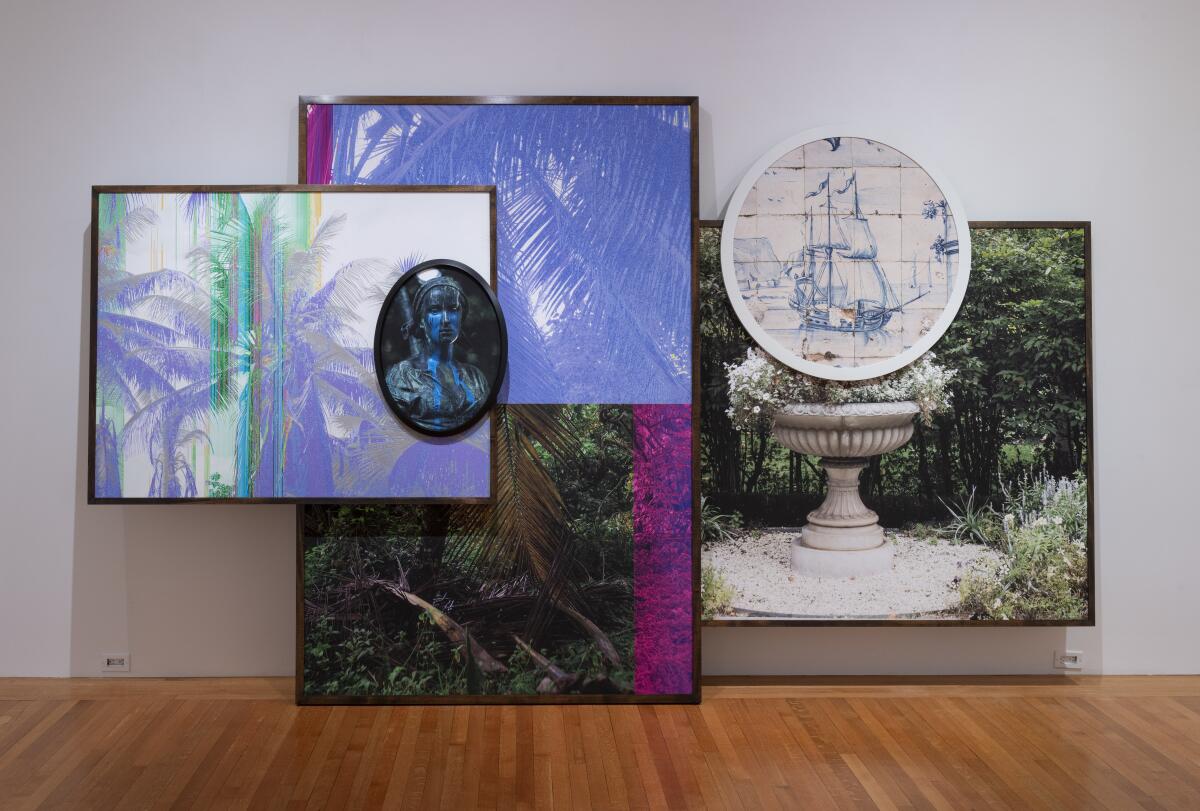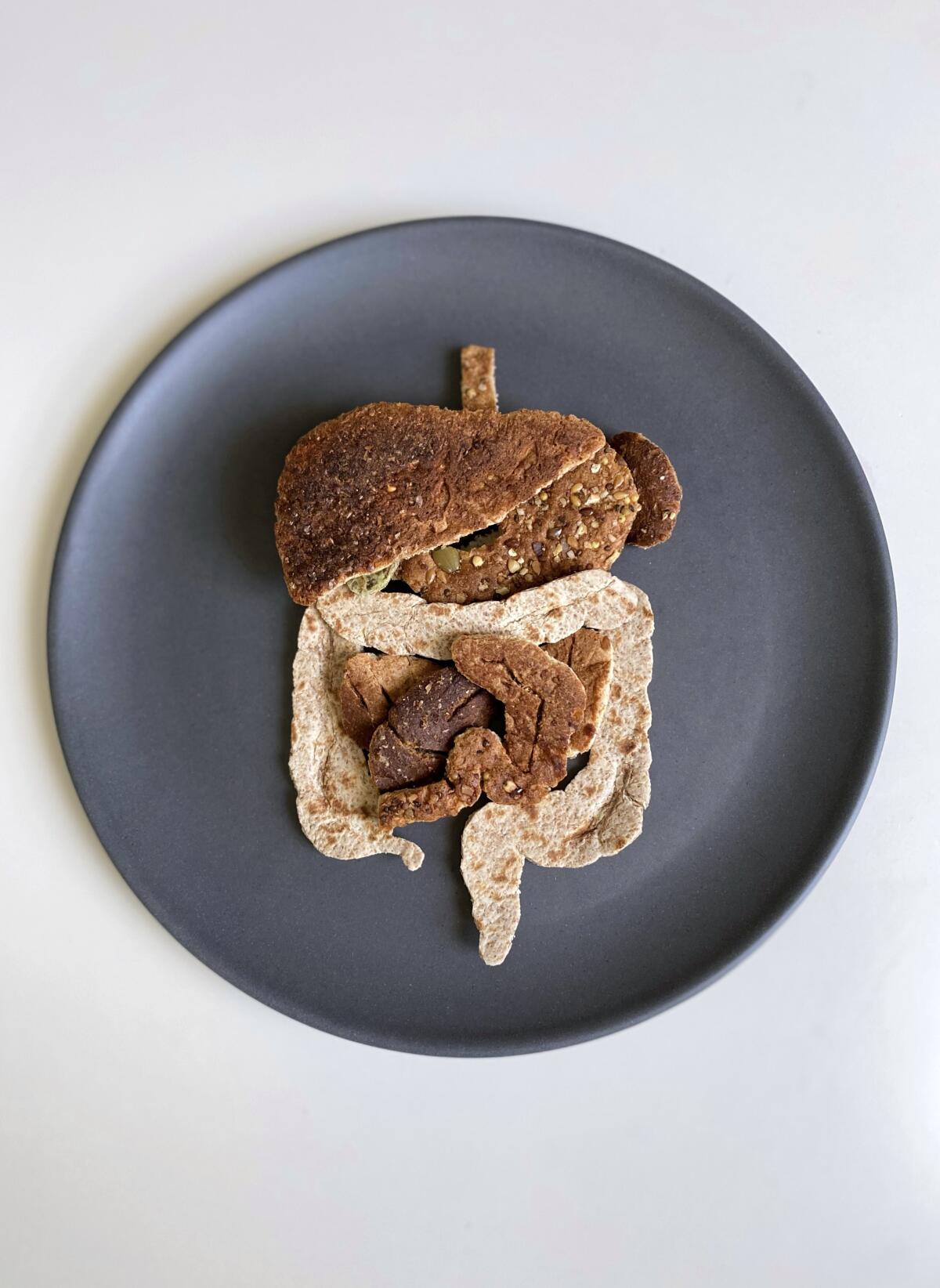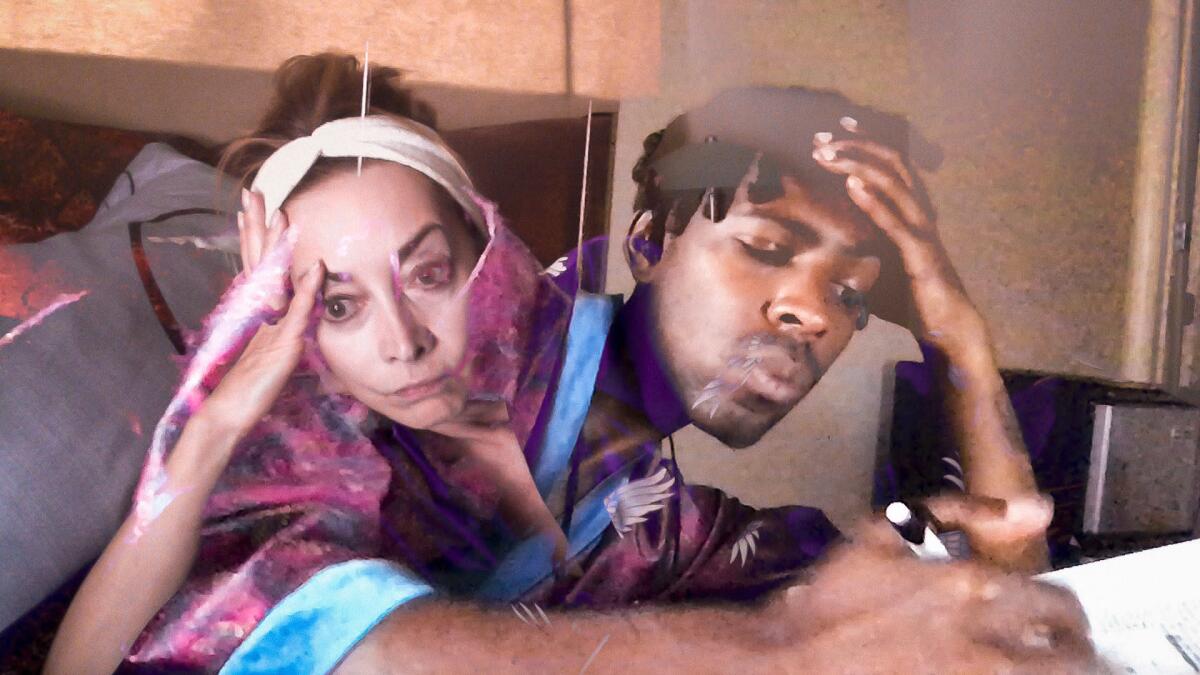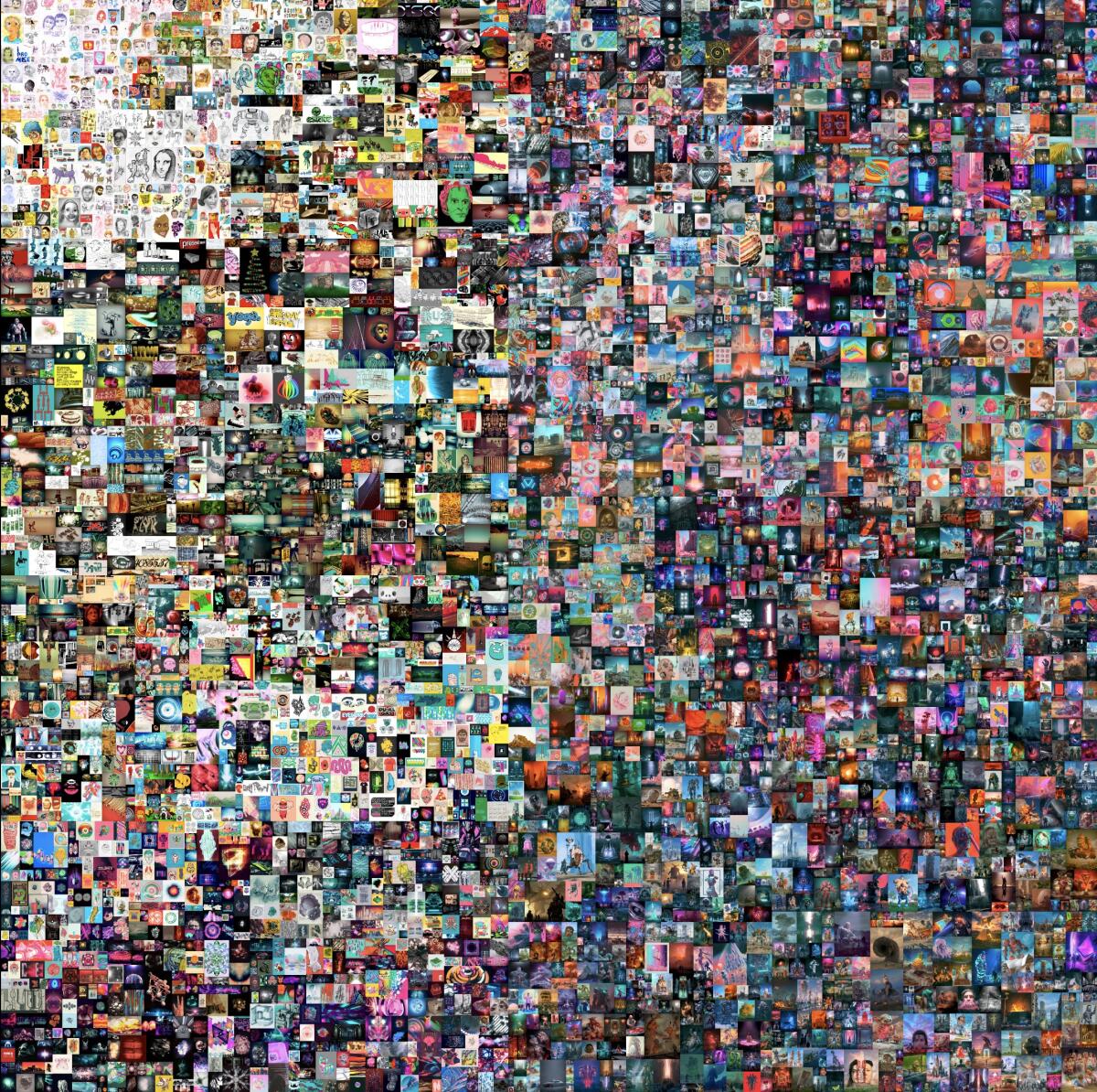Newsletter: Essential Arts: Todd Gray turns colonialism and the art of photography on its head

A digital work by an unknown artist just sold for $69 million, but don’t worry, you guys, the world is totally OK. I’m Carolina A. Miranda, arts and urban design columnist for the Los Angeles Times, with the week’s essential culture news and NSFW NFT takes.
Upside down worlds
It was sociologist Stuart Hall who led Los Angeles artist Todd Gray to rethink the nature of his work. The prolific Jamaican-British theorist, who died in 2014, was noted for his profound examinations of power and the ways in which culture can be deployed to maintain a certain order. In resistance, he noted, there is also power.
Those ideas inspired Gray to exert his own resistance by rattling the conventions of photography. “I started using round frames, I went from 2-D to 3-D, I stopped using glazing,” he explains. “It led me to challenge the assumption of what it meant to properly exhibit a photo.”
The artist began to layer his images in elaborate three-dimensional collages, with images showcased in unorthodox picture frames. (How often do you see a snapshot presented in an ornate, gilded frame?)

In their content, Gray’s pieces also wrestle with power. As the artist told Aperture magazine last year, “Photography is a way for power to have a direct line into subjects, into us, into the masses; to formulate narratives that we don’t question, because we think these narratives are something called reality.”
For his latest solo show, which recently opened at the Wadsworth Atheneum Museum of Art in Hartford, Conn., the artist zeroes in on colonial power and the ways in which it can manifest in barely perceived ways.
“Todd Gray / Matrix 186,” as the exhibition is titled, features a series of works that juxtapose photographs of European imperial gardens with scenery the artist photographed during sojourns in Africa. (Gray, a former commercial photographer, uses almost all his own imagery — except for the occasional Hubble Space Telescope shot of the cosmos, which he downloads from the internet courtesy of NASA.)
In these works, imperial gardens are turned on their side and embedded alongside photos of wetlands in Nigeria and a grove of palms in Ghana. Photographs of European statues are turned upside down and shown alongside a ghostly Nigerian Eyo. Ships — those great conveyers of exploration and the slave trade — intrude on the landscape. These are worlds turned upside down, then spun right side up again.
The show, which was organized by contemporary art curator Patricia Hickson, also features Gray’s largest piece to date, “Sumptuous Memories of Plundering Kings,” which extends to a length of 34 feet. It combines 14 large-scale images of gardens and statuary with images shot around a Lagos stadium and a reproduction of Dutch Renaissance painter Jan Mostaert’s “Portrait of an African Man” (c. 1525-30), thought to be the earliest known portrait of a specific Black man in European painting.

The work is history writ in visceral, photographic form: the landscapes that fed the slave trade are juxtaposed with the people who amassed wealth from it, along with the ghosts that remain.
I saw the piece in Gray’s Hyde Park studio before it was shipped to Connecticut, and it was a truly sensory experience. Its vast scale envelops the viewer — a photographic collage, almost painterly in nature, that requires a literal journey, from one end to another, from the past into the present. (The photos don’t do it justice.)
In a booklet that accompanies the exhibition, artist Carrie Mae Weems says of Gray’s work: “[Todd has] come to understand something about who we are ... through [his] decision to break the frame, to break the mold, and to then recombine, reconfigure, reimagine the consequences of history and the way in which it’s all framed and constructed.”
Or as Gray succinctly put it during a recent telephone conversation: “How do I shake up what is taken for granted?”
Well, consider it shaken.
“Todd Gray / Matrix 186” is on view at the Wadsworth Atheneum Museum of Art through July 18.
Art and the coronavirus
It has been a year. And many have been lost. The COVID-19 death toll in the United States stands at 531,000 as I write this. That is the population of Fresno. In one year, we have lost an entire American city.
To mark this deadly anniversary, Times reporter Jessica Gelt — who is indefatigable — checks in with an array of performers to see how they have weathered the pandemic storm.

She talks to chamber musicians Tereza Stanislav and Robert Brophy about how they recorded part of the soundtrack for Christopher Nolan’s “Tenet” in their garage, featuring rain as added instrumentation, and to French horn player Kyra Sims about how her vibrant pre-pandemic performing schedule (which included a Grammys gig with Lizzo) came to a grinding halt. For Sims it was a time of quiet that has led to other opportunities, including a gig playing on Heartbeat Opera’s visual album “Breathing Free.”
Viola player Corinne Olsen made do with teaching and one-off gigs, while pianist Sharon Su had to put a vibrant program devoted to the work of female composers on hold. Yet even as the pandemic ground on, she still had to sit at the keys and practice.
Make the most of L.A.
Get our guide to events and happenings in the SoCal arts scene. In your inbox once a week.
You may occasionally receive promotional content from the Los Angeles Times.
L.A. Phil musicians Jonathan and Cathy Karoly turned the porch concerts they started early in the pandemic into a Pasadena neighborhood staple, and Alexander Blake, founder of the choral group Tonality, saw performances shift to the web. In the wake of George Floyd’s death, he also co-founded a collective called Black Artists for Black Lives to draw attention to issues of racism and police brutality.
Gelt has many more stories. (You can find them all under this one handy link.) Collectively, they tell of ingenuity and innovation, but also of the ways in which this year of lockup has been a test of our collective psyche.

Early last year, Taymor Iman Jones relocated to Los Angeles to appear in “Hamilton” at the Hollywood Pantages — in what would have been one of her biggest stage roles yet. The pandemic prevented the show from opening. Now she reflects on what COVID-19 has taught her. “I can’t make anything go faster,” she tells Ashley Lee. “I can’t go back to work sooner. What I can do is keep trying to keep my skills tight, and also take time to focus on things I haven’t been able to whenever I’m in a show.”
A couple of months before the safer-at-home orders landed and theaters were shut down, Times theater critic Charles McNulty met with stage director Michael Michetti to discuss his upcoming revival of the Stephen Sondheim-James Lapine musical “Passion” at the Boston Court Pasadena. The show lasted four preview performances before the shutdowns began. Now McNulty checks in a year later. In the strain, the director has found resilience: “We are always having to turn our limitations into strength.”
—> BTW, if you work in theater in L.A., The Times wants to hear from you.
Makeda Easter has an imaginative story that looks at how some healthcare workers have turned to making art as a way of coping with the grueling nature of their work — including needlepoint, drawing, painting, dollhouse construction and dance. There is even a doctor who plays with her food. “Physician burnout is real,” says Dr. Gina Vernace. Art offers an escape from the turmoil.

Plus, my colleague Matt Pearce, who recently joined the culture section after covering the national election for The Times, is hitting the ground running, looking at how the pandemic blurred the already fuzzy line between the internet and real life. It is a shift that has affected every corner of life — culture, education, politics, video games, even grief. “As life expectancies dropped,” he writes, “many of us doomscrolled timelines full of bad news until we fell asleep.”
In other news: The Japanese American National Museum is the site of a memorial to healthcare workers that will debut virtually this weekend, and the Smithsonian National Museum of American History has acquired the vial that contained the first dose of COVID-19 vaccine administered in the United States.
Enjoying this newsletter? Consider subscribing to the Los Angeles Times
Your support helps us deliver the news that matters most. Become a subscriber.
And L.A. and a slew of other California counties will be advancing to the less restrictive red tier over the weekend — meaning museums will be allowed to open next week.
Around the arts
A digital production of Larry Powell’s “The Gaze ... No Homo” tells the story of a Black queer actor played by Galen J. Williams navigating the whiteness of the theater world after he is cast in a production at a prestigious theater festival. There he faces an artistic director (Sharon Lawrence) who is “fluent in diversity-speak and utterly clueless about how her conduct undermines her lip service,” writes Charles McNulty. Some of the plot lines are predictable, but the work “captures in fleeting unconscious images the way racial hostility is internalized.”

On the corner of 3rd Street and Traction Avenue, you will find a fruit vendor who sells ... paintings. The setup, titled “Francisco’s Fresh Paintings,” is a project by artist Francisco Palomares, who is using the stand as a way to engage questions of art and painting directly with his audience. He produces his canvases on site, and his works feature everyday Angelenos, often in surreal ways. A particular area of interest: depicting “everyday Black and brown men with dignity,” he tells reporter Julia Barajas.
What the !*&$ is an NFT?
Thank god for my colleague Sam Dean, who comes through with an explainer of NFTs and that Beeple piece that sold at auction for $69 million. Because I still can’t fully wrap my head around the blockchain. (Cue the GIF of Winona Ryder looking confused.)

Kevin Buist has an interesting critical piece about the phenomenon in Artforum. “The NFT,” he writes, “is a financial innovation masquerading as an art innovation.”
And Dean Kissick has a wonderfully acerbic take in Spike: “I recently wrote for the Spectator about the trend of bad figurative painting that occupies the bardo between content and art: paintings that are easy to enjoy, and also to post. With NFTs, we’ve made another leap from art that’s easy to post, to art that simply is the post.”
And because art world gonna art world: Damien Hirst is now getting into NFTs.
Over on the rising social media app Clubhouse, Marion Maneker writes about how it seems like no one can stop talking about NFTs.
Sort of related: Art writer Jori Finkel spent an entire day on Clubhouse and lived to tell the tale.
When this is all done, I’m gonna collage all the hot takes about NFTs into a single massive hot take about NFTs and then sell it as an NFT art work. Auction houses, I am ready for your call.
Essential happenings
Liza Minnelli. Los Angeles Opera. A performance by the Invertigo Dance Theatre. Matt Cooper rounds up 19 weekend culture picks, including an all-star cast marking Minnelli’s 75th birthday.

Passages
Wilhelmina Cole Holladay, who was key to the establishment of the National Museum of Women in the Arts in Washington, D.C., is dead at 98.
Helen Rae, a Southern California visual artist whose paintings of couture photography offered a unique view on the world, has died at 83.
Photographer Aaron Rose, who was known for his reserve as much as for his technically innovative images of New York, has died at 84.
Nicola Pagett, a British stage and screen actress known for playing the headstrong Elizabeth Bellamy in “Upstairs, Downstairs,” is dead at 75.
In other news
— The Academy Museum of Motion Pictures won’t be open IRL until Sept. 30, but it is rolling out virtual programming in April before the Oscars.
— Related: Sophia Loren and Haile Gerima will be the honorees at the Academy Museum’s opening gala.
— The late Brazilian architect Lina Bo Bardi will be honored posthumously with the Golden Lion for Lifetime Achievement at the next Venice Architecture Biennale.
— Branden Jacobs-Jenkins’ satire “An Octoroon” will be the first play produced on the Fountain Theatre’s outdoor stage.
— Angel Blue, Janai Brugger, Craig Colclough, Joshua Guerrero and Kate Lindsey are the five inaugural winners of a new $50,000 award launched by L.A. Opera for outstanding artists with connections to the company.
— The storied Metro Pictures, the New York gallery that helped cement the reputation of the artists of the Pictures Generation, is closing.
— In light of all the debates about how Britney Spears was treated by the media in the ‘90s, critic Jörg Colberg had a prescient essay about how women are treated by celebrity culture back in 2013.
— Randy Kennedy has a good interview with photographer Bruce Talamon about his highly memorable images of David Hammons at work in the 1970s.
— “He’s probably less a new-model Andy Warhol than a new-model Peter Max.” Artnet’s Ben Davis on the phenomenon that is Kaws.
And last but not least ...
I’ve been enjoying Peter Martinez Zellner’s architecture newsletter. It consists of new and republished essays covering a range of ideas — all of it blessedly free of architecturespeak.
The biggest entertainment stories
Get our big stories about Hollywood, film, television, music, arts, culture and more right in your inbox as soon as they publish.
You may occasionally receive promotional content from the Los Angeles Times.




